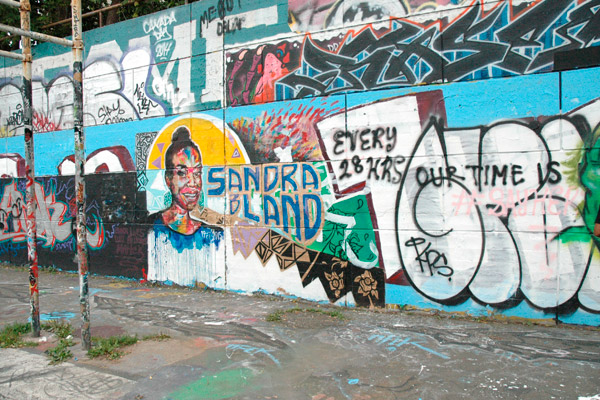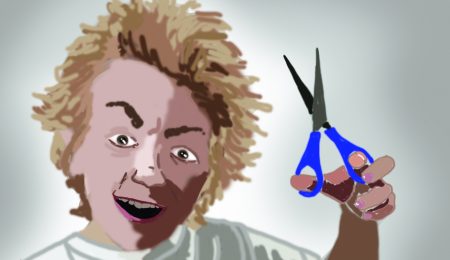The mysterious circumstances surrounding the death of Sandra Bland, a black woman in custody in a Texas jail, sent shockwaves throughout the United States. The incident is only the latest in a series of deaths of black Americans at the hands of law enforcement officials that has fuelled the Black Lives Matter movement. On July 24, a mural of Bland painted on a legal graffiti wall in downtown Ottawa was defaced, proving that we need to remind ourselves here in Canada too, that Black Lives Matter.
Earlier this month, several groups tried to achieve this by painting the rallying cry on the same graffiti wall. The statement lasted a few hours before it was painted over.
Ottawa artist Mike Gall told Metro News that the letters were most likely painted over because of the unwritten rule between graffiti artists that they don’t paint over the work of more skilled artists. “It’s our community that’s been painting here for so long, and we take offense to stuff like this, no matter what the cause,” he said.
But a few days after the original incident, Ottawa artists Kalkidan Assefa and Allan Andre, painted their tribute to Sandra Bland. This time, a white moustache, the words “All Lives Matter”, and other offensive terms left little room for misinterpretation.
But don’t get us wrong, it’s not like Canada has a systemic racism problem or anything. The Canadian government got rid of discrimination years ago. Been there, done that.
Right?
As Canadians we’re uncomfortable with talking about discrimination against minorities, partially because we’re taught that it’s not a problem. We don’t know how to talk about it. In some ways our silence is worse than somewhere like the United States where they’re entrenched in a nation-wide debate about racism.
In a 2012 Toronto Star article covering the enactment of the International Day for the Elimination of Racial Discrimination by the United Nations, Grace Edward Galabuzi, Amy Casipullai and, Avvy Go wrote about the underlying racial divide in Canada.
“Some would say that the March 21 commemoration of the International Day for the Elimination of Racial Discrimination is redundant since every day is a racism-free day in Canada,” they wrote, “indeed, according to an Angus Reid poll, while a third of Canadians (32 per cent) believe that racism is a significant problem in Canada, 55 per cent are satisfied that we have overcome it.”
While there exists numerous legal protections in Canada against discrimination, the Canadian offshoot of the Black Lives Matter movement is meant to address the subtle yet sinister ways race is separating people in the Great White North. Most of us wouldn’t tolerate racial slurs, or segregated schools, but what about the fact that racialized Canadians are three times more likely to live in poverty than other Canadians? Or the overrepresentation of black and aboriginal Canadians in our jails?
Many of us view the overrepresentation of black Americans in prisons as vestiges of the slave trade. But if that were accurate, why is it in Canada, a country that abolished slavery before it was even a country, has similar rates of overrepresentation?
Toronto police stopped more young men of colour from 2008 to mid-2011 in the city’s 72 patrol zones than the actual number that lives there. According to the Star, “not only are racialized people considered a greater crime threat, they also face greater surveillance.”
The United Nations Committee on the Elimination of Racial Discrimination said in 2012 that the Canadian government needs to take “urgent measures” to reduce the overrepresentation of aboriginals and blacks in the criminal justice system and out-of-home care.
The report, which acknowledges some of Canada’s positive policies, flags growing socio-economic gaps among ethnic groups, racial profiling, overrepresentation and discrimination of aboriginal and black Canadians in the criminal justice system as concerns.
The Sandra Bland mural was restored on July 30. However the circumstances that gave rise to the Black Lives Matter movement aren’t as easy to paint over.





